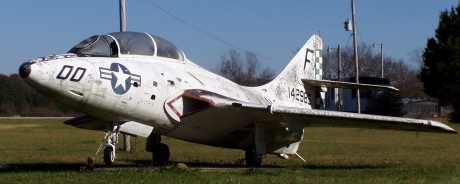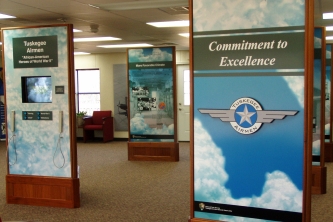NPS Website; Local Website
 WHAT IS IT?
WHAT IS IT?The airstrip and hangar where the first African-American Air Force pilots, navigators and bombardiers were trained for service in World War II.
BEAUTY (2/10)
The temporary Visitor Center is located in a trailer and a rusty barbed-wire fence cordons off the still-working airstrip. The hangar, also behind wire, looks to be falling apart. There is nothing to see here.
HISTORICAL INTEREST (5/10)
Up until 1940, African-American soldiers were not allowed to fly military planes. A 1925 Army War College study proclaimed them to be unfit physically and psychologically to handle aircraft. When World War II began, flight schools sprung up at colleges throughout the United States notably excluding historically black universities. Protests, newspaper columns and eventually NAACP lawsuits would attempt to change this practice.
In late 1941, the U.S. Army Air Corps granted Tuskegee University the right to begin a military flight training school. The instruction occurred here, at Moton Field. By the end of World War II, nearly 1,000 pilots had graduated from the Civilian Pilot Training program and had seen a great deal of combat success over the skies of Europe.
The Tuskegee Airmen played a part in the Civil Rights struggle but it was not African-Americans' first military-related role. Black soldiers have represented this country since Crispus Attucks was killed in the 1770 Boston Massacre, the first casualty of the American Revolution. Black regiments fought in all subsequent wars, including the Civil War. The Buffalo soldier regiments are, in fact, represented at Fort Davis NHS in Texas.
The Airmen NHS leads its pamphlet with unfortunate word choice. It calls the pilot training program the “Tuskegee Experiment”, immediately recalling the sinister U.S. government syphilis injection program that occurred just down the road during the same timeframe, but finds no mention at either Tuskegee Site. A Google search of “Tuskegee Experiment” does not bring up a reference to pilot training until the 57th entry. Is no one at the NPS paying attention?
CROWDS (5/10)
There was no one else at the Site.
EASE OF USE/ACCESS (4/5)
The current temporary Visitor Center as well as the future site of the Tuskegee Airmen NHS is located just off Alabama Route 81, a few miles south of Interstate 85, Exit 38, just north of the town of Tuskegee.
CONCESSIONS/BOOKSTORE (3/5)
The selection is limited but focused. Eight of the dozen titles deal solely with the Site’s subjects, the Tuskegee Airmen.
COSTS (4/5)
The Site is free.
RANGER/GUIDE TO TOURIST RATIO (4/5)
Two Rangers, two of us.
 TOURS/CLASSES (4/10)
TOURS/CLASSES (4/10)We relied upon the Site’s 15-minute video, oversized panels and previous visit to the Tuskegee Institute to guide us. The grounds are off-limits. The Rangers seemed bored. We were hard-pressed to think of questions. A panel with a map and diagram are mounted on the back porch of the temporary VC, giving one the impression a walking tour is possible. It is not.
FUN (3/10)
We didn’t stay long, not because we had a bad time, but because we couldn’t think of anything else to do. Video – watched it. Explanations – read them. Tours – wished for them. Historic artifacts – drove up to the gate and looked at them. The Rangers on site predicted that the new Visitors Center would be ready in a few years, as would enhanced access to the airfield. Today, the Tuskegee Airmen NHS feels like a non-contiguous addendum to the Tuskegee Institute NHS rather than a site in its own right.
WOULD WE RECOMMEND? (3/10)
The Tuskegee Airmen NHS is an under whelming tourist destination and pales in significance and power to Tuskegee Institute, Selma (Voting Rights Museum and the Edmund Pettus Bridge), the Freedom Trail and Montgomery (Rosa Parks’ Bus, Martin Luther King’s Dexter Avenue Baptist Church and the Civil Rights Memorial).
TOTAL 37/80
www.usa-c2c.com
© 2004-06